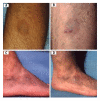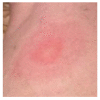Presentation of Acrodermatitis Chronica Atrophicans Rashes on Lyme Disease Patients in Canada
- PMID: 32512846
- PMCID: PMC7349802
- DOI: 10.3390/healthcare8020157
Presentation of Acrodermatitis Chronica Atrophicans Rashes on Lyme Disease Patients in Canada
Abstract
Lyme disease (Lyme borreliosis) is a complex multisystem illness with varying clinical manifestations. This tick-borne zoonosis is caused by the spirochetal bacterium, Borrelia burgdorferi sensu lato (Bbsl) and, worldwide, presents with at least 20 different types of rashes. Certain cutaneous rashes are inherently interconnected to various stages of Lyme disease. In this study, five Canadian Lyme disease patients from a multi-age range presented various phases of the acrodermatitis chronica atrophicans (ACA) rash. In each case of ACA, the underlying etiological pathogen was the Lyme disease spirochete. Although ACA rashes are normally found on the lower extremities, this study illustrates that ACA rashes are not directly correlated with a tick bite, geographic area, age, Bbsl genospecies, exercise, or any given surface area of the body. Case 4 provides confirmation for an ACA rash and gestational Lyme disease. One patient (Case 5) puts forth a Bbsl and Bartonella sp. co-infection with a complex ACA rash. This study documents ACA rashes on Lyme disease patients for the first time in Canada.
Keywords: Borrelia burgdorferi sensu lato; Canada; Lyme disease; acrodermatitis chronica atrophicans; persistence; rashes; symptoms; ticks.
Conflict of interest statement
The author declares no conflicts of interest.
Figures






References
Grants and funding
LinkOut - more resources
Full Text Sources

